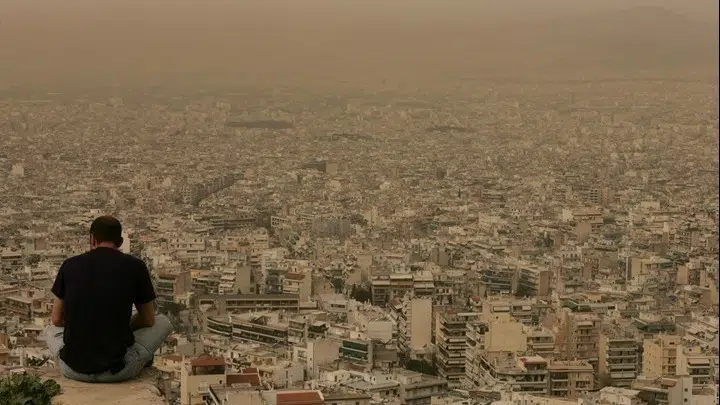
A dust cloud from the African continent blew over the eastern Mediterranean, shrouding large swathes of Greece in a haze. On Thursday, the phenomenon is anticipated to continue.
Much of the country, including the capital Athens, has severely impaired vision due to the dust cloud.
The southern island of Crete was particularly heavily struck. Airborne dust levels there have been above 50 mg/m³ in the western parts.
33 ° βαθμους Κελσίου πριν από λίγο στο Ηράκλειο, η Κρήτη θα σκεπαστεί από Αφρικανική σκόνη οσονουπω. #Ηντα_θα_γενούμε_οφέτος_κοπέλια pic.twitter.com/eGc7QkPV75
— Μανόλης della Creta (@baxebanis) March 27, 2024
The elderly, small children and those with respiratory conditions have been recommended by the local health authorities to minimize their outside activities.
The most noteworthy repercussions of the African dust clouds in Greece will be:
- an increase in temperatures in the next few days
- restricted visibility in various places
- muddy rain, mostly in western and northern parts of the country
Dust and sand are associated with health problems
The African dust is associated with health problems in the general population in Greece. It has been observed that on days with dust concentrations, hospital admissions increase.
Research conducted by Greek and foreign scientists has identified a whole list of hazardous heavy metals in the African dust. This is alarming to society, as the African dust has been “traveling” to Greece more and more frequently over recent years due to the increased desertification in the Sahara.
According to assessments, the dust and sand that travel from Africa to Greece transport poisonous substances, such as lead, zinc, chromium, vanadium, arsenic, and nickel in much higher quantities than previously thought.
Formation of African dust and sand clouds
In order for Saharan dust to impact systems around the globe, it must first become airborne and leave the Sahara Desert.
The Bodélé Depression is one of the most significant sites of Saharan dust and sand cloud formation. The depression is composed of dried lake beds which are now covered by dunes.
Winds moving at speeds between 6 and 16 m/s (13-35 mph) through this region pick up loose sediment and transport the dust away from the Sahara.
Naturally, higher wind speeds lead to the transport of greater amounts of dust in this region. The highest output of dust from this area occurs from spring through fall.
The Sahara is the largest source of aeolian dust in the world, with annual production rates of about 400-700 x 106 tons/year, which is almost half of all aeolian desert inputs to the ocean. Saharan dust is often produced by natural process such as wind storms and doesn’t appear to be heavily impacted by human activities.
See all the latest news from Greece and the world at Greekreporter.com. Contact our newsroom to report an update or send your story, photos and videos. Follow GR on Google News and subscribe here to our daily email!



